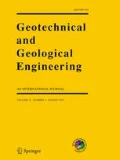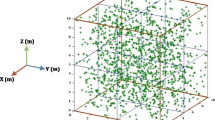Abstract
The study of contaminants propagation in fractured and karstic aquifers shows uncertainties caused by the conditions of anisotropy of the medium and by the presence of cavities and residual products that could make fluid flow and solute transport unforeseeable. Therefore, in aquifers characterized by fissured and fractured solid matrix, in order to set up remediation strategies, it is necessary to represent the conditions of groundwater flow and contaminant propagation in such a way as to take into consideration the high heterogeneity connected to the presence of fractures and channels that act as preferential flow ways. The study carried out in a specified site, located in the city of Bari, heavily contaminated by petroliferous substances allows to build a model able to simulate subterranean draining conditions that prove to be as near as possible to the real ones. This simulation could be helpful for the prevision of the dynamic behavior of the aquifer during the period of the treatment in order to allow optimizations on the technical and economical point of view and in order to check the effective functionality of the system in the presence of anthropic constraints.














Similar content being viewed by others
References
Barenblatt GE, Zheltov IP, Kochina IN (1960) Basic concepts in the theory of seepage of homogeneous liquids in fissured rocks. J Appl Math (USSR) 24(5):1286–1303
Cassan M (1980) Les essais d’eau dans la reconnaissance des sols. Eyrolles, Paris
Cherubini C, Giasi CI, Castore M, De Palma D, Errede V, Guastamacchia M (2004a) Analysis and visualization of data and construction of the hydrogeologic model to study the remediation of the ‘ex Gasometer’ area in the city centre of Bari (Italy). UDMS 2004, 24th Urban Data Management Symposium, October 27–29, 2004, Chioggia–Venice, Italy
Cherubini C, Giasi CI, Masciopinto C (2004b) Stochastic fracture flow modelling and influence of the computational procedures on the pollutants migration in a case study FEM MODFLOW international conference on finite element. KarlovyVary, Czech Republic 2004
Cherubini C, Giasi CI, Masciopinto C (2006) Flusso di contaminanti in sottosuoli fratturati: diversi approcci modellistici a confronto in un sito industriale dismesso. In printing on “Acque sotterranee”—Fascicolo 103-Ottobre 2006, pp 9–16, A.N.I.P.a. Milano
Diersch HJG (2002) FEFLOW finite element subsurface flow and transport simulation system––User’s manual/Reference manual/White papers. Release 5.1. WASY Ltd, Berlin, 2002
Di Fazio A, Masciopinto C, Troisi S (1998) Prova si Tracciamento con NaCl: misura dei parametri idrogeologici e influenza della diffusione molecolare. IGEA-Groundwater Geoeng 10:19–25
Indraratna B, Ranjith P (2001) Hydromechanical aspects and unsaturated flow in jointed rock. A.A Balkema publishers
Iwai K (1976) Fundamental studies of the fluid flow through a single fracture, Ph.D. dissertation, University of California, Berkeley, California
Francani V (1995) Idrogeologia generale e applicata. CLUP, Milano
Gattinoni P, Papini M, Scesi L (2003) Geologia applicata: applicazione ai progetti di ingegneria civile. Casa Editrice Ambrosiana, Milano
Giasi CI (1982) Sulle problematiche connesse alla prevenzione della influenza marina sulle falde acquifere in aree carsiche. Geologia Appl e Idrogeol 17
Kiraly L (1969) Anisotropie et hétérogéneité de la perméabilité dans les calcaires fissurés. Eclogae Geologica Helvetiae 62(2):613–619
Kiraly L (1998) Modeling karst aquifers by the combined discrete channel and continuum approach. Bulletin du Centre d’Hydrogeologie, Neuchatel 16:77–98
Kiraly L, Morel G (1976) Etude de regularisation de l’Areuse par modele mathematique. Bulletin du Centre d’Hydrogeologie, Neuchatel 1:19–36
Kovács A (2003) Geometry and hydraulic parameters of karst aquifers: a hydrodynamic modeling approach. Ph.D. thesis, University of Neuchâtel, Switzerland, 131 p
Long JCS, Remer JS, Wilson CR, Witherspoon PA (1982) Porous media equivalents for networks of discontinuous fractures. Water Resour Res 18(3):645–658
Masciopinto C (1999) Particles transport in a single fracture under variable flow regimes. Adv Eng Softw 35(5):327–337
Neretnieks I (1983) A note on fracture flow dispersion mechanisms in the ground. Water Resour Res 19(2):364–370
Priest SD, Hudson JA (1976) Discontinuity spacings in rock. Int J Rock Mech Min Sci Geomech Abstr 13:135–148
Ruskauff GJ (1998) Stochastic MODFLOW for [13]Monte Carlo simulation. Guide to using in groundwater Vistas v. 4. ESI Team: Rumbaugh JO, Rumbaugh DB, Copyright 2000–2004, Environmental Simulations. Inc.
Snow DT (1969) Anisotropic permeability of fractured media. Water Resour Res 5(6):1273–1289
Teutsch G, Sauter M (1991) Groundwater modeling in karst terranes: scale effects, data acquisition and field validation. 3rd Conference on hydrology, ecology, monitoring and management of ground water in karst terranes, Nashville, USA
Teutsch G, Sauter M (1998) Distributed parameter modeling approaches in karst-hydrological investigations. Bulletin du Centre d’Hydrogeologie, Neuchatel 16:99–109
Witherspoon PA, Wang JSY, Iwai K, Gale JE (1980) Validity of cubic law for fluid flow in a deformable rock fracture. Water Resour Res 16:1016–1024
Author information
Authors and Affiliations
Corresponding author
Rights and permissions
About this article
Cite this article
Cherubini, C. A Modeling Approach for the Study of Contamination in a Fractured Aquifer. Geotech Geol Eng 26, 519–533 (2008). https://doi.org/10.1007/s10706-008-9186-3
Received:
Accepted:
Published:
Issue Date:
DOI: https://doi.org/10.1007/s10706-008-9186-3




